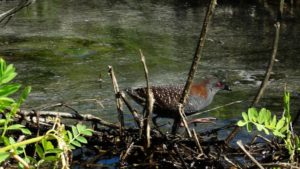Black Rail Bird Threatened – Offsetting Good News (next week)

The 6″ small Eastern Black Rail bird as harbinger of something huge
I once wrote for the worthy “Bay Journal Daily News” a story about natural shorelines; a particularly great project just off the Severn River at Annapolis.
 In its lead piece on Monday, I was dismayed to find an article by Karl Blankenship about the Eastern Black Rail bird population being threatened by sea level rise. Their habitat, marshlands along the Chesapeake Bay and elsewhere along the Eastern Seaboard, is being drowned.
In its lead piece on Monday, I was dismayed to find an article by Karl Blankenship about the Eastern Black Rail bird population being threatened by sea level rise. Their habitat, marshlands along the Chesapeake Bay and elsewhere along the Eastern Seaboard, is being drowned.
But, let me interrupt this post for a certain kind of context-
“Regarding the March 10 news article ‘EPA’s leader dismisses climate-change science’: Environmental Protection Agency Administrator Scott Pruitt has said that ‘measuring with precision human activity on the climate is something very challenging to do.’ I can note with experience that we can say the same about hurricane landfall: not precise, but devastating. We know it’s going to happen and the lack of precision does not stop coastal communities in harm’s way from preparing for the worst.
“D. James Baker, Washington. The writer was administrator of the National Oceanographic and Atmosphere Administration from 1993 to 2001.” Letters to the Editor, The Washington Post, 3.13.17
Back to the small Eastern Black Rail bird and the “Bay Journal” article.
“‘We know almost nothing about this species,’ …ornithologist Bryan Watts, director of the Center for Conservation Biology in Virginia, [told Blankenship]. ‘It’s very tiny and incredibly secretive. Even most bird watchers have never seen this species before.'”
The Black Rail bird is about 6″ long, and is active between midnight and about 4am.
“Now, even hearing their call is unlikely. Its habitat, a delicately balanced zone deep within coastal marshes, is being flooded by rising waters. And the Eastern black rail is disappearing fast — potentially becoming the first victim of sea level rise around the Chesapeake Bay and other areas of the East Coast.”
Its nests and eggs are what are going under as entire marshland habitats are flooded.
Because the bird’s population has dropped some 90% in well less than 3 decades, the U.S. Fish and Wildlife Service may protect it through the federal Endangered Species Act. A recommendation is expected to be made in later 2018.
As sea level rise has been noted more recently, you might ask yourself if something else contributed to the Eastern Black Rail’s near-extinction over the 25-year period? How ’bout substantial coastal urbanization that’s included paving over wetlands? ‘Dozer blades versus biodiversity.
Yes, several islands have already disappeared in the Chesapeake Bay, but inhabitants found somewhere else to move to.
BTW, Earth Day 2017’s coming soon (Saturday, April 22)
Consider doing something about it. Check with local schools or area environmental non-profits for their sponsorship programs.
Among my choices are planting trees along Catoctin Creek, MD, sponsored by the Chesapeake Bay Foundation. Or, closer to home: Community Trash Cleanup with Friends of Herring Run Park, sponsored by Blue Water Baltimore.
